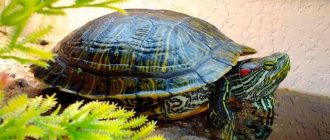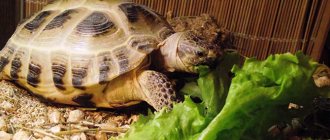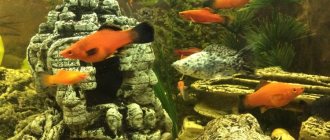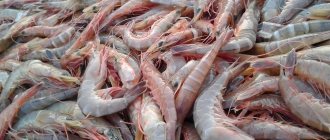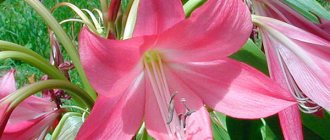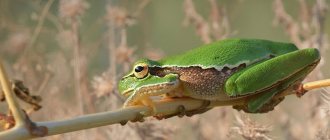Aquarium frogs are amphibians adapted to life in an artificially created aquatic environment. Some species that are now bred in captivity are also found in nature, but others were obtained as a result of selective breeding.
These pets often require special conditions and cannot always live in the same aquarium with fish and shellfish. In addition, they need an island of land where they can take a break from the aquatic environment.
Who are frogs?
In order to understand the proper maintenance of such creatures and understand who frogs are, you need to understand what exactly they are.
So, frogs are part of one large class of Amphibians or Amphibians. What should we understand from this? And the fact that these creatures can live both on land and in water. This animal kingdom has a separate order in this class - Anurans, which has about 6,000 modern and 84 fossil species.
Compatibility in an aquarium with fish
The clawed toad and the African toad have completely different personalities. Dwarf frogs are peace-loving, while clawed frogs are merciless absorbers of all living things.
You cannot house the clawed toad with fish, as all the fish that fit in its mouth will be quickly eaten. These are restless, active amphibians, so don’t be surprised if one day you find dug up or broken plants, bitten fish and dislodged decorations.
Peaceful African aquarium frogs get along well with peaceful, small fish. Predators should not be introduced, since the danger is precisely amphibians, which predatory fish are not averse to feasting on.
Who Shouldn't Own a Frog
Perhaps, it’s worth thinking about getting a frog if these creatures don’t cause you panic or disgust, since all people perceive the environment and its inhabitants differently. Since antiquity, these animals have been viewed with apparent ambivalence. Some attributed them to participation in witchcraft rituals, where they were used as ingredients, while others had beliefs that it was impossible to kill them, as they brought good luck and prosperity to the house.
If you consider a frog as an ordinary animal, with its own characteristics, behavior and character, then you can see that they are quite pleasant creatures. They have beautiful expressive eyes, a whole variety of colors, and their movements are very interesting to watch. They are fun to look after.
Nutrition
Insectivorous frogs are predators, happily eating mosquitoes, butterflies and small invertebrates. Particularly large ones do not disdain more impressive prey; some species of animal frogs even mercilessly devour their own relatives.
To hunt their victims, frogs use a sticky and long tongue, which they use to deftly catch midges, dragonflies and other living creatures in mid-flight. Among the frog species there are also omnivores that happily eat fruit.
Frogs bring quite a lot of benefits to humans, destroying and eating many harmful worms, beetles and insects. Therefore, many owners of vegetable gardens and household plots treat such helpers with great sympathy and create all the conditions for them to breed and live.
Frogs are eaten, making them extremely original dishes, which are delicacies and are used for gourmet tables.
Benefits of Keeping a Frog
The advantages of such a pet include not only their cute appearance, but also their ability to adapt to any climate conditions. This class of animals has perfectly mastered the entire globe and was able to adapt to life in any element. If you were sure that they live only in ponds and swamps, your knowledge will be expanded. Their habitats are much wider than those familiar to us. They mastered the desert and polar borders. They live both in the city and in wild places where people have not lived at all.
If you have thought about it and decided to purchase such a pet, then you will need to be careful about the type of frog that you prefer. Each species is unique in its own way.
Diseases
Sudden cooling, frequent water changes, obesity, stress, parasites and infection cause various diseases in frogs. Sick frogs are separated and isolated. When purchasing a new animal, it must be quarantined separately from other animals. This will prevent the spread of possible diseases.
Common diseases:
- Fungal diseases. A white coating forms on injured areas of the skin, which, if left untreated, appears throughout the skin. Antifungal drugs are used for treatment.
- Red paw. Red paw is an infectious disease, the causative agent is bacteria. Manifested by the appearance of bruises on the paws and face
- Nematode infection. When the disease occurs, the skin loses its color, becomes gray, peels, and falls off. Small worms are examined on the affected areas.
- Dropsy. Dropsy is caused by a bacterial infection. The frog's body swells and becomes almost round.
- Helminths. When infected with helminths, the animal loses weight sharply. Treated with anthelmintic drugs.
If normal conditions are maintained, many diseases will not appear in the aquarium.
Types of frogs to keep
Common tree frog
This small tree frog can most often be found in terrariums. She has a good appetite, a gentle character, and entertaining behavior. It is not difficult to keep, but it is worth noting that it eats live insects. If you come across a male of this species, expect periodic chants, this is their nature. Among this species there is a whole variety: , harlequin tree frog, red-eyed tree frog, coral tree frog. But it is worth noting that many of them are poisonous! Please take this into account when purchasing. Always wash your hands after handling them.
Slingshot
Due to her appearance, as well as her large mouth and huge belly, she was nicknamed Pacman (the character from the video game Pac-Man). It comes in a variety of colors and is perhaps the most popular type of frog to keep at home. She has good eyesight and is good at hiding. This can be great fun, since the slingshot also changes color depending on the interior. He leads a sedentary lifestyle, which simplifies the issue of space. The slingshot eats live food, such as crickets.
Far Eastern Fire Toad
In appearance it resembles a toad. Ideal for home keeping, as it has a beautiful color and is active during the day. The toad eats live insects. It doesn't grow too big.
African dwarf
This is a small, active frog that requires little care and is perfect for beginners. It does not require constant presence in the water. No live food required.
Other types of frogs
These are just a few of the available options to choose from. In any case, it is better to purchase familiar types of frogs that you can keep at home.
It is better to refuse wild species, due to the complexity of properly maintaining an unknown species (unless, of course, you are an expert in this field), dietary requirements and your own safety. In addition, a frog caught in the wild may be a protected species, and taking it from its natural habitat will disrupt the population of its species.
Representatives of the pipidae family
The Greek word “amphibian” (two-life) best characterizes the familiar frog, brown or green.
Everyone knows from school zoology courses that frogs and toads are amphibious creatures, closely associated with two habitats at once. But there are sixteen species of exotic frogs, interesting for their almost “fishy” way of life. Scientists divide these “originals” into four genera, which as a whole make up the family Pipidae. Anyone who has read Gerald Durrell’s story “Three Tickets to Adventure” will remember the Suriname “toad with pockets” when they hear the word “pipa” - large, up to 20 centimeters long, with a very ridiculous, in my opinion, appearance and an extremely interesting method of reproduction. Its African relatives - the clawed frogs - over the past two decades have turned into ordinary aquarium pets (being, however, animals that are not for everyone).
Representatives of the pipidae family can live in heavily polluted, oxygen-depleted water bodies, but in aquariums they cannot tolerate even small concentrations of free chlorine or chloramines dissolved in water. These frogs rarely come onto land. Due to life under water, their eyes became small and lost their eyelids, and their tongue and eardrum atrophied. The anatomy of the limbs has also undergone changes: between the toes of the powerful hind legs, the swimming membrane has noticeably increased, and in some species, a membrane has even appeared on the front legs.
Most of the frogs of this interesting family live in Eastern and Southern Africa. Only five species that make up the genus Pipa inhabit the waters of South America.
The most numerous and accessible to the aquarist are clawed frogs. Hymenochiruses and dwarf pipas very rarely appear on sale, and they are expensive. The little frogs are very similar in appearance. Adult individuals are clearly distinguished by physical characteristics, and it is no longer possible to confuse the species.
The clawed frog has highly developed muscular hind legs, the toes of which end in short (2-3 millimeters) and sharp black claws - a kind of “spurs”. These frogs are also called clawed frogs. With the help of claws, they protect themselves from small predators and are kept among the stems of plants, resisting the flow of water. The front legs are short, with long, thin, unwebbed toes. The body length of sexually mature frogs is from 6 to 13 centimeters. The head is small, flattened, the muzzle is short, round, the eyes are turned upward. On the sides of adult animals, organs of touch are visible in the form of a dotted line - similar to the lateral line in fish. Males are noticeably smaller than females; the anus of the female is covered by three skin folds.
Of the five species of clawed frogs (genus Xenopus), only the smooth clawed frog (X. laevis) has become a true home aquarium and laboratory species. In its homeland - in Africa (from Kenya and Angola to Cape Town) it inhabits both temporary puddles and permanent reservoirs with stagnant water. Leads a sedentary lifestyle, loves to soak in the mud and silt, where it buries itself almost completely. At the same time, he is a good swimmer, able to deftly escape from a pursuing predator.
Clawed frogs come to land only in rare cases: during a drought, when they have to leave a dry body of water, or during the rainy season. They are not able to feed on the ground.
Hymenochirus boettgeri is very tiny. Its length is 3.5-4 centimeters. The body is covered with fine-grained skin. Hymenochirus differs from other pipidae in the small membranes between the toes of the front paws, for which they received the scientific name, the literal translation of which is “leather-handed”. Of all the water frogs, they are perhaps the most graceful and confident swimmers.
Pipa Corvalho, or Brazilian dwarf pipa (Pipa corvalhoi), lives in stagnant waters in northern South America, settling among thickets of plants and driftwood. It prefers places with a muddy bottom, into which it buries itself at the slightest fright. Dwarf peeps have a more flattened body than clawed frogs, the head has the shape of a triangle when viewed from above, and there are characteristic leathery “stars” at the ends of the toes of the front paws (apparently these are organs of touch). Body length 6 centimeters. Adult males are smaller and flatter, and are noticeably darker in color than females. Young pipas are very similar to Hymenochirus of the same size, but Hymenochirus swim more slowly and calmly in the water column. Peeps quickly rise to the surface of the water for air and rush down even faster to hide at the bottom. When swimming, the toes of their front paws are straightened (in Hymenochirus they are most often bent).
Water frogs are quite cute. Unfortunately, their coloring does not shine with beauty: the upper body is dark gray or grayish-brown with blackish spots and streaks, sometimes with an olive tint, the underside is white with a grayish tint and vague brownish markings. Brown clawed frogs are occasionally seen. In Moscow, in the laboratory of the Institute of Developmental Biology, an albino clawed frog was accidentally bred and propagated. Quite quickly she won the sympathy of domestic and foreign aquarists. The body of albinos is yellowish-white or pale pink, the bottom is pure white, the eyes are red, and the claws remain black.
Selecting a space
You can determine the size of your terrarium (or other tank) by the size of your adult frog. For a more accurate selection, the points below should be taken into account.
Type of frog
You need to know exactly what type of frog you choose to have an accurate idea of how big it can grow. When you come to a pet store, do not be put off by the sellers: they may be poorly informed on this issue. It’s better to read about certain species right away, look for information about them, and only after you are absolutely sure of the characteristics of your pet, buy a tank.
Frog size
The larger the frog, the more free space it will need. If the aquarium is small, your animal will get sick and suffer; you definitely won’t make it happy. Small species require less food and aquarium stocking costs, which in turn makes them more desirable to novice owners. You will have to clean up less after them. Some species have a tiny appearance, but this can be deceiving. For example, the Elf frog - its initial size is 2.5 centimeters, and it can reach 20 cm. Always check first.
Housing for agile jumpers
The requirements for “living space” for frogs are modest: even a 3-5 liter jar will suit small individuals, but for ease of observation it is better to use an aquarium with a capacity of 20 liters or more (50-60 liter is already a luxury). It should be remembered that frogs like to hide in secluded places, actively dig in the ground and, much more than fish, pollute the water with their secretions.
The main disadvantages of clawed frogs are their large size and predatory habits. If they are placed together with fish, the frogs will definitely eat all the smaller and weaker neighbors. Peeps are only dangerous to small things the size of guppy and neons. And for the completely harmless Hymenochirus, on the contrary, the proximity of large, voracious and cocky fish is extremely undesirable.
Anyone who keeps water frogs must remember that the aquarium must be covered with glass or mesh. Claw frogs are agile jumpers. They can suddenly (usually at night) leave their home for no apparent reason, and then they will inevitably die quickly from drying out. Hymenochiruses are also capable of jumping out of an aquarium, not to mention pips, which can climb vertical glass well thanks to the mucous membrane of the lower part of the body. The glass covering the aquarium, of course, must have a sufficient number of ventilation holes: after all, frogs breathe by rising to the surface of the water and swallowing atmospheric air.
Once on the floor, the clawed frog demonstrates amazing agility, sliding on its wet belly, trying to return to its native element as quickly as possible. It is difficult to catch an incredibly slippery jumper: even when clenched in a fist, it “seeps” between the fingers, becoming almost flat, or, having turned into a lump of muscles, desperately kicks and kicks, trying to scratch the hand that grabbed it.
It is better to use fine river gravel or granite chips 4-6 millimeters in size as soil in the aquarium. Such soil is inconvenient to stir up, and it will not muddy the pond. Sand, on the contrary, contributes to the accumulation of silt, frogs in search of food stir it up, and the water in the aquarium becomes dirty. However, for pipidae this does not matter; they only do not like an oily film on the surface of the water, which prevents them from swallowing air.
Plants suitable for a “paddling pool” are large enough, with strong stems and leaves, and a powerful root system. Considering the habit of frogs to dig under unstable objects, the lower part of the plant bushes should be covered with stones.
Soil and plants decorate the pond and provide biological balance. However, with good filtration or frequent water changes, frogs feel great in a completely empty aquarium with a couple of clay shards-shelters at the bottom. By the way, you should not use powerful filters: being inhabitants of stagnant waters, pipidae do not like rapid flows with bubbles.
Frogs are less sensitive to water quality than the most unpretentious fish species. When cleaning the aquarium, use regular tap water for replacement, which has been left to sit for one to two days. Naturally, sudden changes in temperature should be avoided. Blowing water with a microcompressor, despite the pulmonary breathing of amphibians, is useful, but if it is not there, it is also not a problem. An interesting feature of Hymenochirus was noticed by amateurs. It happens that a “herd” of one and a half dozen specimens sits in a simple 3-liter jar, without any purging or filtration, in muddy “old” water - the health of each frog is excellent, but transplant them into a decorative aquarium, ideal, from a human point of view , conditions - illnesses begin.
Hymenochirus are the most capricious of water frogs. It is advisable to maintain the water temperature for them at least 20, and preferably 24°C, since in cool water the body’s resistance to infectious and fungal diseases sharply decreases.
Dwarf pipas also love warmth, but are more tolerant of low temperatures.
The optimal temperature for keeping clawed frogs is normal room temperature, that is, 18-22°C.
It must be remembered that frogs are quite nervous and impressionable creatures. They do not like loud noises, such as knocking, near the aquarium. In a panic, the frogs begin to rush about sharply, hitting walls, stones, plants, lifting silt from the bottom. This timidity does not go away for the rest of their lives, so treat it with understanding. At the same time, frogs easily get used to taking pieces of meat from a knitting needle, tweezers, and even from their hands.
Types of frog tanks
- Ground tank
. This is the simplest type. Suitable only for land amphibians.
- Water tank
. This species is for aquatic amphibians only.
- Tank, where the ratio is 50/50
. The most common type is where half is filled with water and the other half is dry. This is the kind of home that suits most frogs.
- Wood tank
. The name says it all, this home is only for arboreal species that love branches. This house is tall and narrow, unlike the others. - Pond
. If you have a private plot, you can create your own pond there, where you can add several species of native frogs.
Interesting Facts
deer, smearing arrows with poison.
Temperature
It all depends on the type of frog you have. Most of them do not require special lighting. If the house is located far from natural light, a 12-hour light source is required. Use a lamp with fluorescent lamps for this - this is the safest option. If you need to change the temperature in your aquarium, the easiest option is to cool or heat your apartment. The temperature in the water can be heated with a glass tube, which is sold in specialized stores, or with an immersion water heater. This entire process must be constantly monitored and the frog must be provided with a safe place to stay during this time.
Care
Frogs catch cold easily when the temperature drops sharply. In this situation, special aquarium heating is used to maintain a constant temperature. The reservoir is filled to half its capacity. The top must be covered, otherwise the animal will jump out of the water. There should always be access to fresh air; the top of the aquarium should not be completely closed. Examine your wards for diseases or skin lesions or wounds.
Feeding
Pets eat animal food better. Dry food is not eaten or in small quantities.
Feed Xenopus:
- worms;
- crickets;
- large bloodworm;
- fry.
Give chopped liver, shrimp, and lean meat in small quantities.
Amphibians will independently find food at the bottom or in the water of the aquarium with their keen sense of smell. Hymenochiruses feed on bloodworms, cut fish, and daphnia.
Dwarf frogs search for food for a long time, so you should place food near them.
Feed 2 times a week.
Feeding the frog
In this matter, again, you should base your decision on the type of frog you choose.
Live food
Remember that most species of frogs prefer live food, meaning you will need to be able to buy crickets, caterpillars, worms, fish, mice. It is better to buy all these living creatures in specialized stores, and not dig them up or catch them in the garden behind the house, as these pests can be chemically poisoned.
Water
The water needs to be changed regularly. They bathe in it and drink through the skin. The water must be dechlorinated, this is important.
Breeding
Reproduction is stimulated by increasing water temperature and updating it to clean water. Before breeding, black stripes appear on the male's paws, then he makes melodious sounds, calling the female to mating games. For spawning, a spawning tank depth of at least 20 cm is required. The female lays 50-200 eggs; after the eggs appear, the parents should be separated from the brood.
Newborn tadpoles are small in size, no more than 3 mm. Starter food: rotifers and ciliates. After a year they become adults.
Recommended reading and useful links
- Maslova I.V. The influence of climate on certain aspects of the life activity of amphibians and reptiles (Russian): collection / Comp. A. O. Kokorin. - Moscow: WWF Russia, 2006. - P. 111. - ISBN 5895640370. - Bibcode: 26.23В58.
- Ananyeva N. B., Borkin L. Ya., Darevsky I. S., Orlov N. L. Five-language dictionary of animal names. Amphibians and reptiles. Latin, Russian, English, German, French. / under the general editorship of academician.
- Ferrell, Vance. Geographical Distribution. Evolution Encyclopedia, Volume 3. Evolution Facts (March 4, 2012). Dahl, Chris; Novotny, Vojtech; Moravec, Jiri; Richards, Stephen J. Beta diversity of frogs in the forests of New Guinea, Amazonia and Europe: contrasting tropical and temperate communities // Journal of Biogeography (English) Russian. : journal. - 2009. - Vol. 36, no. 5. - P. 896?904. — DOI:10.1111/j.1365-2699.2008.02042.x.
- Shabanov D. A., Litvinchuk S. N. Green frogs: life without rules or a special way of evolution? (Russian) // Nature: magazine. - Science, 2010. - No. 3. - P. 29-36.
- Kartashev N.N., Sokolov V.E., Shilov I.A. Workshop on vertebrate zoology.

